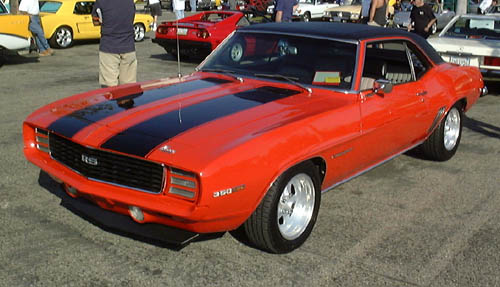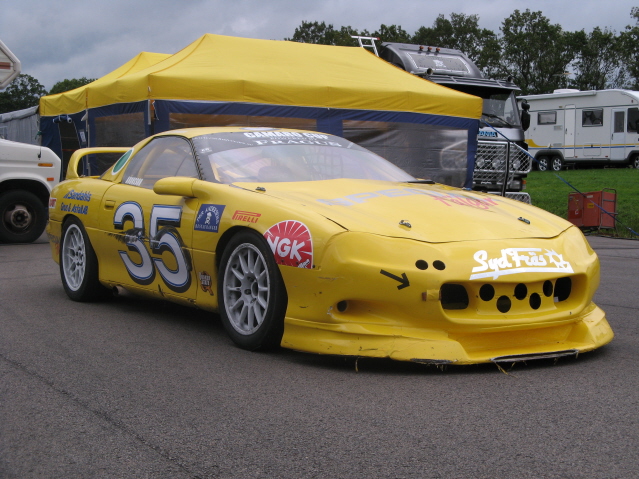The Chevrolet Camaro is an automobile manufactured by the Chevrolet division of General Motors, classified as a pony car or muscle car.It went on sale on September 29, 1966 for the 1967 model year and was designed as a competing model to the Ford Mustang. The car shared its platform and major components with the Pontiac Firebird, also introduced for 1967. Four distinct generations of the car were developed before production ended in 2002. The nameplate was revived again on a concept vehicle that evolved into the fifth-generation Camaro, production started on March 16, 2009.
Origin.
Before any official announcement, reports began running in April 1965 within the automotive press that Chevrolet was preparing a competitor to the Ford Mustang, code-named Panther.On June 21, 1966, around 200 automotive journalists received a telegram from General Motors stating, "...Please save noon of June 28 for important SEPAW meeting. Hope you can be on hand to help scratch a cat. Details will follow...(signed) John L. Cutter – Chevrolet Public Relations – SEPAW Secretary." The following day, the same journalists received another General Motors telegram stating, "Society for the Eradication of Panthers from the Automotive World will hold first and last meeting on June 28...(signed) John L. Cutter – Chevrolet Public Relations SEPAW Secretary." These telegrams puzzled the industry.
On June 28, 1966, General Motors held a live press conference in Detroit’s Statler-Hilton Hotel. It would be the first time in history that 14 cities were hooked up in real time for a press conference via telephone lines. Chevrolet General Manager Pete Estes started the news conference stating that all attendees of the conference were charter members of the Society for the Elimination of Panthers from the Automotive World and that this would be the first and last meeting of SEPAW. Estes then announced a new car line, project designation XP-836, with a name that Chevrolet chose in keeping with other car names beginning with the letter C such as the Corvair, Chevelle, Chevy II, and Corvette. He claimed the name, "suggests the comradeship of good friends as a personal car should be to its owner" and that "to us, the name means just what we think the car will do... Go!" The new Camaro name was then unveiled. Automotive press asked Chevrolet product managers, "What is a Camaro?" and were told it was "a small, vicious animal that eats Mustangs."
The Camaro was first shown at a press preview in Detroit, Michigan on September 12, 1966 and then later in Los Angeles, California on September 19, 1966. The Camaro officially went on sale in dealerships on September 29, 1966 for the 1967 model year.
First generation.
The first-generation Camaro debuted in September 1966, for the 1967 model year, up to 1969 on a new rear-wheel drive GM F-body platform and would be available as a 2-door, 2+2 seating, coupe or convertible with a choice of 250 cu in (4.1 L) inline-6 and 302 cu in (4.9 L), 307 cu in (5.0 L), 327 cu in (5.4 L), 350 cu in (5.7 L), or 396 cu in (6.5 L) V8 powerplants. Concerned with the runaway success of the Ford Mustang, Chevrolet executives realized that their compact sporty car, the Corvair, would not be able to generate the sales volume of the Mustang due to its rear-engine design, as well as declining sales, partly due to bad publicity from Ralph Nader's book, Unsafe at Any Speed. Therefore, the Camaro was touted as having the same conventional rear-drive, front-engine configuration as Mustang and Chevy II Nova. In addition, the Camaro was designed to fit a variety of power plants in the engine bay. The first-generation Camaro would last until the 1969 model year and would eventually inspire the design of the new retro fifth-generation Camaro.
Second generation.
Introduced in February 1970, the second generation Camaro would remain in production through 1981. The car was somewhat larger and wider with the new styling, thus resulting in a heavier car.Still based on the F-body platform, the new Camaro was similar to its predecessor, with a unibody structure, front subframe, an A-arm front suspension and leaf springs to control the solid rear axle. The RS, SS and Z28 performance packages remained, though the Z28 received an engine upgrade to the LT-1 350 cu. in. unit; Road & Track magazine picked the 1971 SS350 as one of the ten best cars on the planet in August 1971. 1980 and 1981 Z28's included a rear facing intake, with an intake door that opened under full throttle.
Third generation.
The third generation Camaro was produced from 1982 to 1992. These were the first Camaros to offer modern fuel injection, Turbo-Hydramatic 700R4 four-speed automatic transmissions, five speed manual transmissions, 16 inch wheels, a standard 4 cylinder engine and versatile hatchback bodies. The cars were nearly 500 pounds lighter than the long running second generation model. The legendary IROC-Z was introduced in 1985. In 1987, the potent L98 5.7 V-8 engine was available in the Z28, paired with an automatic transmission. The "20th Anniversary Commemorative Edition" was offered in 1987 and a "25th Anniversary Heritage Package" in 1992. Beginning in 1988, the famed 1LE performance package was introduced, for the street models and for showroom stock racing in the U.S. and Canada. The B4C or "police" package was made available beginning in 1991. This basically created a Z28 in more subtle RS styling.
Fourth generation.
The fourth-generation Camaro debuted in 1993 on an updated F-body platform. It retained the same characteristics since its introduction in 1967: a coupe body style with 2+2 seating (with an optional T-top roof) or convertible (introduced in 1994), rear-wheel drive, and a choice of V-6 and V-8 engines. The standard powerplant from 1993-1995 was a 3.4 liter V-6. A more powerful 3.8 liter V-6 was introduced as an option in 1995 and made standard in 1996. The LT1 V-8 engine, which was introduced in the Corvette in 1992, was standard in the Z28. Optional equipment included all-speed traction control and a new six-speed T-56 manual transmission; a four-speed automatic transmission was also available. Anti-lock brakes were standard equipment on all Camaros. The 1997 model year included a revised interior, and the 1998 models included exterior styling changes, and a switch to GM's aluminum block LS1 used in the Corvette C5. The Camaro remained in production through the 2002 model year, marking 35 years of continuous production. Production of the F-Body platform was stopped due to slowing sales, a deteriorating market for sports coupes, and plant overcapacity.
Fifth generation.
Based on the 2006 Camaro Concept and 2007 Camaro Convertible Concept, and sharing the same chassis and suspension architecture as the Australian GM Holden VE rear wheel drive sedan, production of the fifth-generation Camaro was approved on 10 August 2006. Oshawa Car Assembly produces the new Camaro which went on sale in spring of 2009 as a 2010 model year vehicle.
Production began on March 16, 2009. The 2010 Camaro is offered as a coupe only in LS, LT, and SS trim levels.[17][18] LS and LT models are powered by a 3.6 L (220 cu in) V6 producing 304 hp (227 kW) mated to either a 6-speed manual or a 6-speed automatic with manual shift. The SS is powered by the 6.2 L (380 cu in) LS3 V8 producing 426 hp (318 kW) and is paired with a 6-speed manual. The automatic SS gets the L99 V8 with 400 hp (300 kW). The RS appearance package is available on both the LT and SS.
Racing.
The Camaro was one of the prominent vehicles in the SCCA-sanctioned Trans-Am Series. Chevrolet contracted Roger Penske to operate their "unofficial" factory-backed Trans Am team, winning the title in 1968 and 1969 with Mark Donohue. Jim Hall's Chaparral team replaced Penske for the 1970 season. Warren Agor of Rochester, NY, was the series' leading Camaro privateer, his orange #13's often jousting with the factory cars. Maurice Carter of car dealer Maurice Carter Chevrolet-Oldsmobile in Hamilton, Ontario, Canada took a new Camaro off his lot and entered the 1970 Trans-Am Series. Carter earned the highest placed Canadian independent driver score of all the Trans-Am racers. Camaro were in use in Trans-Am until the late 1990s and won further titles in 1991, 1992, 1993, 1994, and 1998.
There was also another SCCA Trans-Am Series Camaro that wasn’t popular because of racing but because of its body modifications. This Camaro had been built and driven by Henry “Smokey” Yunick. It had proudly worn the number 13 and in later years would make people look back on it. Smokey Yunick was an innovator ahead of his time when building the 1968 Camaro. He brought a new style into the racing world in many ways. The Camaro had acid dipped body parts, thinner safety glass and other weight reducing devices.
The Penske/Donohue Camaros also had the front sheet metal dropped, all four fenders widened, windshield laid back, front sub-frame “Z’d” to lower the car, the floor pan moved up and even the drip-rails were moved closer to the body. This Camaro had always kept its stock look and only had a 302 engine that was able to produce 482 horsepower. This Camaro had later on been bought by Vic Edelbrock. At this time he put it to use as a test car for new age Chevy small block performance part. One part that had come out of his testing was the Edelbrock Cross-Manifold. To this day the Smokey Yunick 1968 Camaro is owned by Vic Edelbrock Jr.
Camaro Cup race car.
Bob Jane won both the 1971 and 1972 Australian Touring Car Championships at the wheel of a Camaro.
The Camaro was the official car of and used in the International Race of Champions starting in 1975 and lasting for 12 years until 1989. It was the first American car of the series succeeding the Porsche Carrera RSR.
Today, Camaros are raced in many forms of auto racing throughout the world. They are a favorite in drag racing and can be currently found in several series from the National Hot Rod Association, International Hot Rod Association, and United States Hot Rod Association. Road racing Camaros can currently be found in the Sports Car Club of America's American Sedan series. They have also been the exclusive vehicle used in the Swedish Camaro Cup series since 1975.
The Camaro not only participated in racing, but was bestowed the honor of Indianapolis 500 Pace Car duties in 1967, 1969, 1982, 1993, and 2009. The Camaro also paced races at Daytona, Watkins Glen, Mosport in Canada and Charlotte Motor Speedway.
The Camaro was also a regular in the IMSA GT Series.
The fifth-generation Camaro is expected to take to the tracks in 2010 in the GT class of the Grand Am Road Racing Championship. Stevenson Motorsports has announced it is seeking to run a two-car team of Pratt & Miller built cars, based on the same spaceframe as its existing Pontiac GXP-R. The team already runs Camaros in the Koni Challenge Series.
Notable appearances.
The Camaro has also made several notable appearances in film. One of the most popular movie Camaros was a black 1967 model driven by actor John Cusack in the 1985 film Better Off Dead. It also appeared in the music video for "Top back" by rapper T.I. featuring Young Dro, Young Jeezy, Big Kuntry and B.G.
Bumblebee depicted as a 1976 and 5th-gen Camaro concept variant.
In addition, the Camaro continues to find its way into modern day fiction. The vehicle mode of the character Bumblebee in the 2007 film, Transformers, is first a 1976 model Camaro and later a fifth-generation concept variant. A modified fifth-generation Camaro reprises the role of Bumblebee in the sequel, Transformers: Revenge of the Fallen.
Muscle Car

Arva Ära...

Black Ages

esmaspäev, 30. november 2009
Chevrolet Camaro.
Tellimine:
Postituse kommentaarid (Atom)

Kommentaare ei ole:
Postita kommentaar